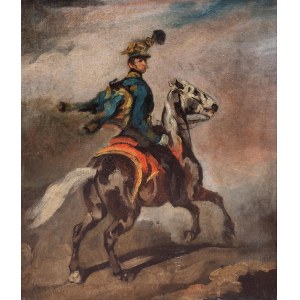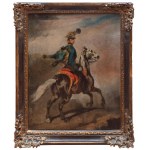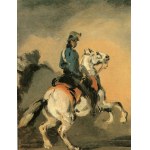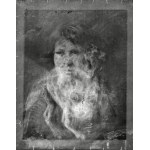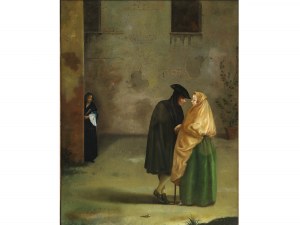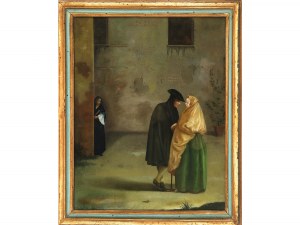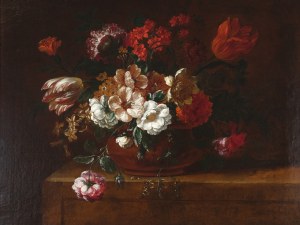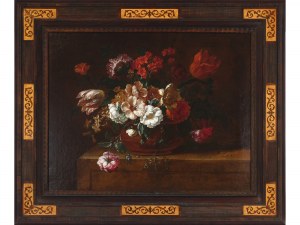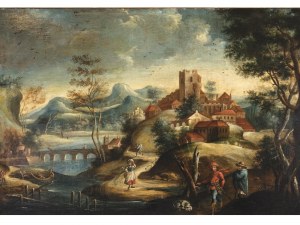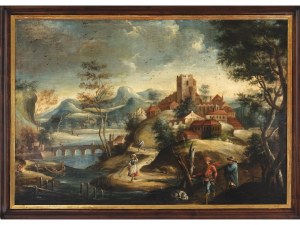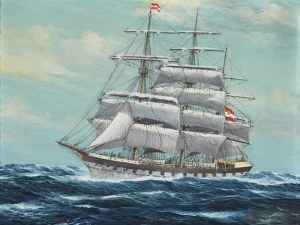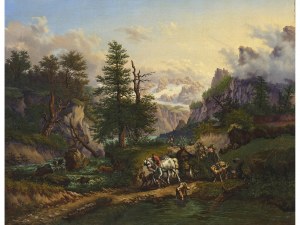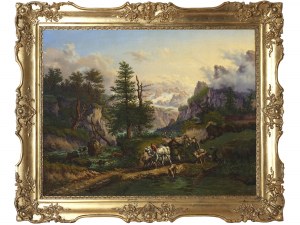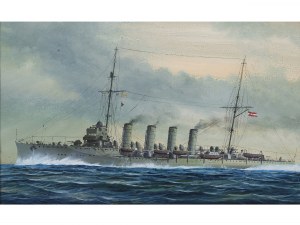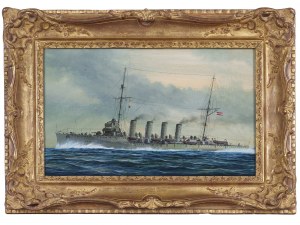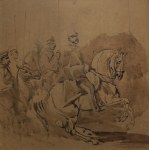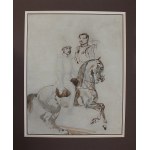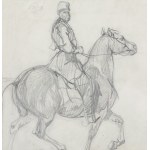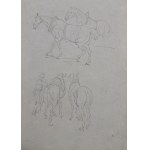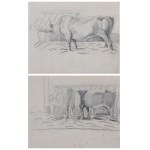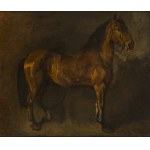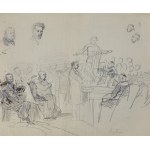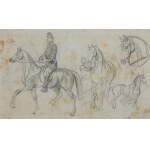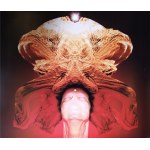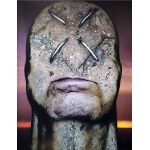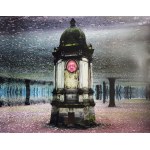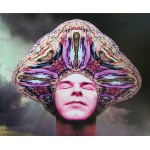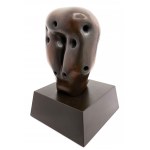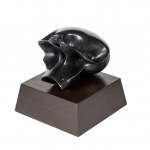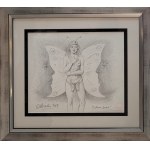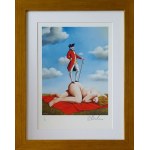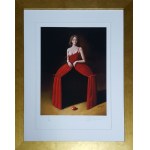oil, canvas, 53 × 43 cm
on the reverse a sticker from the Berlin framing workshop Labuske & Schmidt; on the loom an illegible circular stamp and an inscription in pencil: "Large 35"
directly below the painted hussar is a portrait of a boy in uniform; in the lower part of the canvas - a portrait of a mustachioed man in headgear (composition inverted 180 degrees)
Provenance:
- Circa 1932 collection of Dominik Lempicki, grandson of the artist.
- Private collection, Poland.
Reproduced and described:
- Mieczysław Sterling, "Piotr Michałowski 1800-1855", Warsaw 1932, p. 88, il. IX (here as "Austrian Hussar," 1832-1927)
- "Piotr Michałowski 1800-1855: An Exhibition of the Artist's Works on the Bicentennial of His Birth," exhibition catalog, National Museum in Kraków, Kraków 2000, item XIII, p. 210 (appendix paintings not exhibited), (here as "Hussar Austrian and "Hussar Austrian on Horseback").
Comparison:
- "The Blue Hussar," Österreichische Galerie Belvedere in Vienna (illustrated).
"A separate path, because the path of genius goes Piotr Michalowski, a true and perhaps the first genius in the development of Polish art. To this extraordinary personality, to this sincere, fresh, highly original and profound nature, powerful in everything he touched with his energetic hand, it is impossible to apply the fine scale with which talents of only temporary, historical significance are measured. The position and importance of Piotr Michałowski in Polish art is absolute, not historical."
Prof. Bołoz Antoniewicz, "Illustrated Catalogue of the Exhibition of Polish Art from 1764-1889" General National Exhibition, Lviv 1894. quoted by M. Sterling, "Piotr Michałowski 1800-1855", Warsaw 1932, p. 10
The presented "Blue Hussar" belongs to the series of Austrian Hussars, considered by researchers as one of the most important in Michałowski's work. This theme appeared in the artist's paintings after his return from Paris: "in mid-September of 1835, Piotr Michałowski returned from Paris to Cracow summoned by his father, who, "increasingly burdened by his age, missed his son and longed to have him with him." Certainly, in view of the extraordinary success that "Michalowski's" watercolors with a horse motif enjoyed in Paris at the time, as well as the associated prospects for a great artistic career there, this was not an easy decision. However, the painter did not intend to give up his ambitious plans and, having set up an atelier in the spacious rooms of the Wielopolski palace, continued to create works for sale, mainly on the French market, facilitated by Parisian art dealers and the artist's father-in-law Antoni Ostrowski, who settled in France." ("Piotr Michałowski 1800-1855," MNK 2000, p. 137). It was at that time that the artist's attention was drawn to the soldiers of the Hussar Regiment of Frederick William III, King of Prussia, stationed in Podgórze near Krakow. They were called "blue hussars" because of the dark blue color of their uniforms. Clad in striking, richly decorated uniforms, riding beautiful horses, the hussars - became an excellent inspiration for the artist, who loved hippy and military subjects. From the letters of Julia, the artist's daughter, we learn that Michałowski worked on this theme around 1837. The hussar series continued by the painter even after 1850 ("Piotr Michałowski 1800-1855. Exhibition of the Artist's Works on the Bicentennial of His Birth", exhibition catalog, MNK 2000, pp.158-159.). The dating of the later paintings takes into account the change in uniforms that was introduced in the Austrian army around 1850. Michalowski painted hussars both in a single shot and collectively during exercises or parades.
The featured painting is "one of such sought-after and highly regarded ones that came out of the masterful hand of Piotr Michałowski" (J. Sienkiewicz, "Piotr Michałowski," Warsaw 1959, p. 47). In the collection of the Österreichische Galerie Belvedere in Vienna there is a painting analogous to the one presented here, "The Blue Hussar" ("Hussar on a
gray horse", "Österreichischer Husar" (see illustration), which is dated 1836-1837. It is an analogous composition to the offered one. The two paintings differ in the color of the horse (gray in the Viennese painting and bay in the offered canvas), the different arrangement of the cavalryman's figure and the size of the canvas (26x20 and 53x43 cm). From a letter from his daughter Julia Michalowska (letter dated March 11, 1837), we learn that the artist was already selling his "Blue Hussars" paintings to both France and Austria with great success during the Cracow period. These were watercolors as well as medium-sized oil paintings. Hence, it is difficult to know the approximate number of paintings created. We do know that some of them never left the studio, including the work on display, which remained in the collection of Dominic Lempicki's grandson and was only presented after the artist's death. As K. Ostrowski wrote: "Some were shown at the Lviv exhibition in 1894, although Jerzy Mycielski regretted that "several of the most beautiful", then in the possession of Władysław Michałowski in Cracow, were not exhibited. The aforementioned author emphasized in these images the apt characterization of the colorfulness of the blue Hussar uniforms, "playing in the sun and raised by the golden reflections of the cords and loops, the flickering of light on the gold trim and buttons (....), on the white putty caps, on the sabers and barbed spurs, and finally on the glistening coat of mounts of all kinds" ("Piotr Michałowski 1800-1855...", op. cit. p. 137).
The offered "Austrian Hussar" belonged to the collection of the artist's family for two generations. Its owner was Dominik Lempicki (1883-1939), the artist's grandson, the youngest son of his daughter Maria (1848-1920) and Adam Lempicki of the Junosza coat of arms (1836-1894). Dominik was a Knight of Malta, a volunteer in the Polish-Bolshevik war in 1920, and a co-founder of the Malta Hospital during the defense of Warsaw in September 1939. He died at his post on September 24, 1939.
Recently viewed
Please log in to see lots list
Favourites
Please log in to see lots list



